Account Closing
This workflow describes all the steps required for a Client Service Associate (CSA) to initiate and manage a client service request. As opposed to the Associate Advisor (AA), the CSA typically manages the following Service Request processes: New Account Opening, Money Movement In, Money Movement Out, Client Information Change, Account Features, Client Communications, Account Profile Change, Account Liquidation, Account Closing, and all other General Service Requests.
| Manual |
Diagram |
|
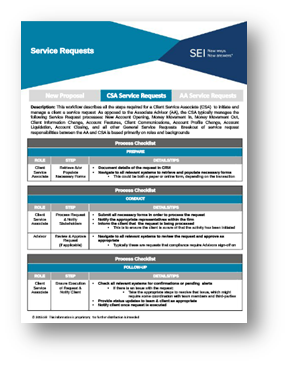
|

|
Account Features
This workflow describes all the steps required for a Client Service Associate (CSA) to initiate and manage a client service request. As opposed to the Associate Advisor (AA), the CSA typically manages the following Service Request processes: New Account Opening, Money Movement In, Money Movement Out, Client Information Change, Account Features, Client Communications, Account Profile Change, Account Liquidation, Account Closing, and all other General Service Requests.
| Manual |
Diagram |
|
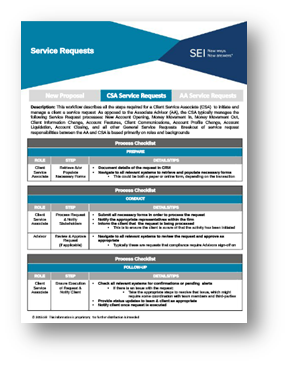
|

|
Account Liquidation
This workflow describes all the steps required for a Client Service Associate (CSA) to initiate and manage a client service request. As opposed to the Associate Advisor (AA), the CSA typically manages the following Service Request processes: New Account Opening, Money Movement In, Money Movement Out, Client Information Change, Account Features, Client Communications, Account Profile Change, Account Liquidation, Account Closing, and all other General Service Requests.
| Manual |
Diagram |
|
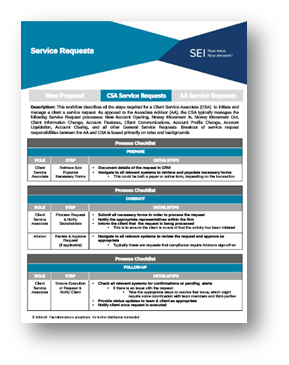
|

|
Account Profile Change
This workflow describes all the steps required for a Client Service Associate (CSA) to initiate and manage a client service request. As opposed to the Associate Advisor (AA), the CSA typically manages the following Service Request processes: New Account Opening, Money Movement In, Money Movement Out, Client Information Change, Account Features, Client Communications, Account Profile Change, Account Liquidation, Account Closing, and all other General Service Requests.
| Manual |
Diagram |
|

|
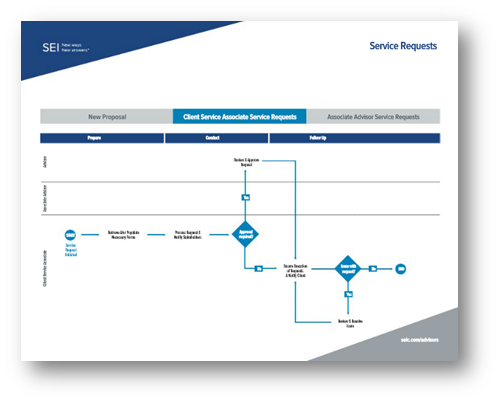
|
Client Communications
This workflow describes all the steps required for a Client Service Associate (CSA) to initiate and manage a client service request. As opposed to the Associate Advisor (AA), the CSA typically manages the following Service Request processes: New Account Opening, Money Movement In, Money Movement Out, Client Information Change, Account Features, Client Communications, Account Profile Change, Account Liquidation, Account Closing, and all other General Service Requests.
| Manual |
Diagram |
|
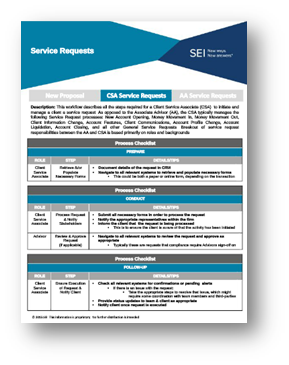
|
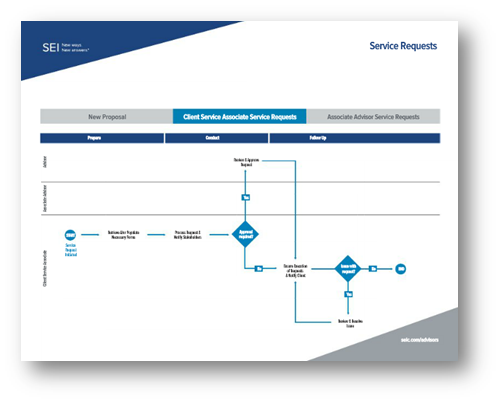
|
Client Information Change
This workflow describes all the steps required for a Client Service Associate (CSA) to initiate and manage a client service request. As opposed to the Associate Advisor (AA), the CSA typically manages the following Service Request processes: New Account Opening, Money Movement In, Money Movement Out, Client Information Change, Account Features, Client Communications, Account Profile Change, Account Liquidation, Account Closing, and all other General Service Requests.
| Manual |
Diagram |
|

|

|
Fee Management
This workflow describes all the steps required for an Associate Advisor (AA) to initiate and manage a client service request. As opposed to the Client Service Associate (CSA), the AA typically manages the following Service Request processes: Strategy Management (Portfolio Level), Fee Management, Trade Requests, and Tax Management.
| Manual |
Diagram |
|

|
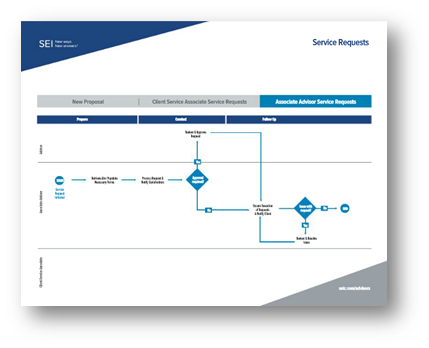
|
General Service Requests
This workflow describes all the steps required for a Client Service Associate (CSA) to initiate and manage a client service request. As opposed to the Associate Advisor (AA), the CSA typically manages the following Service Request processes: New Account Opening, Money Movement In, Money Movement Out, Client Information Change, Account Features, Client Communications, Account Profile Change, Account Liquidation, Account Closing, and all other General Service Requests.
| Manual |
Diagram |
|

|
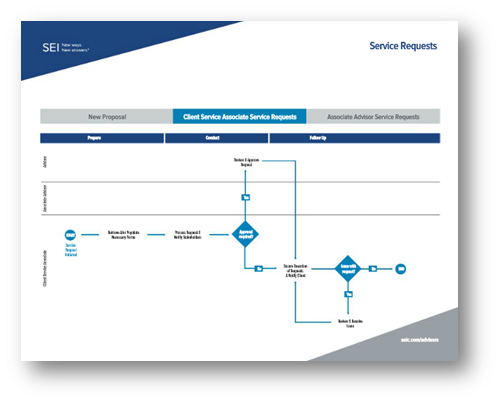
|
Money Movement In
This workflow describes all the steps required for a Client Service Associate (CSA) to initiate and manage a client service request. As opposed to the Associate Advisor (AA), the CSA typically manages the following Service Request processes: New Account Opening, Money Movement In, Money Movement Out, Client Information Change, Account Features, Client Communications, Account Profile Change, Account Liquidation, Account Closing, and all other General Service Requests.
| Manual |
Diagram |
|

|

|
Money Movement Out
This workflow describes all the steps required for a Client Service Associate (CSA) to initiate and manage a client service request. As opposed to the Associate Advisor (AA), the CSA typically manages the following Service Request processes: New Account Opening, Money Movement In, Money Movement Out, Client Information Change, Account Features, Client Communications, Account Profile Change, Account Liquidation, Account Closing, and all other General Service Requests.
| Manual |
Diagram |
|
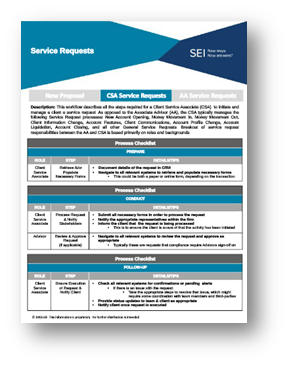
|
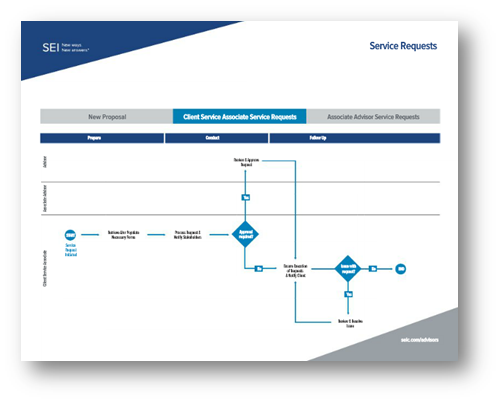
|
New Account Opening
This workflow describes all the steps required for a Client Service Associate (CSA) to initiate and manage a client service request. As opposed to the Associate Advisor (AA), the CSA typically manages the following Service Request processes: New Account Opening, Money Movement In, Money Movement Out, Client Information Change, Account Features, Client Communications, Account Profile Change, Account Liquidation, Account Closing, and all other General Service Requests.
| Manual |
Diagram |
|
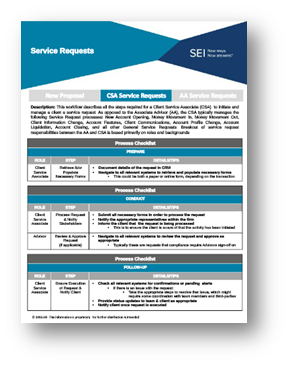
|

|
New Proposal
This workflow describes all the steps required to prepare and present a proposal to an existing client. In this scenario, typically the proposal has already been discussed with the client to some extent, and this is a matter of documenting and presenting the proposal to get the client's sign-off to move forward with implementation. This workflow differs from the Proposal Meeting workflow, which is typically reserved for a more formal meeting with a prospect.
| Manual |
Diagram |
|
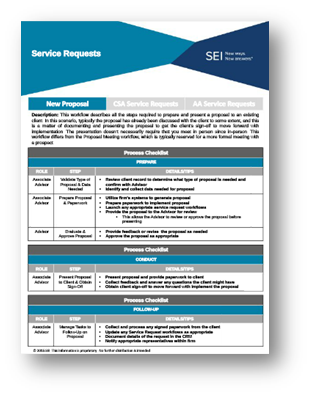
|
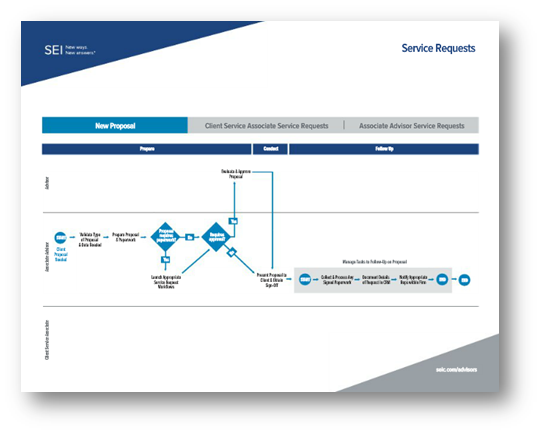
|
Strategy Management
This workflow describes all the steps required for an Associate Advisor (AA) to initiate and manage a client service request. As opposed to the Client Service Associate (CSA), the AA typically manages the following Service Request processes: Strategy Management (Portfolio Level), Fee Management, Trade Requests, and Tax Management.
| Manual |
Diagram |
|

|
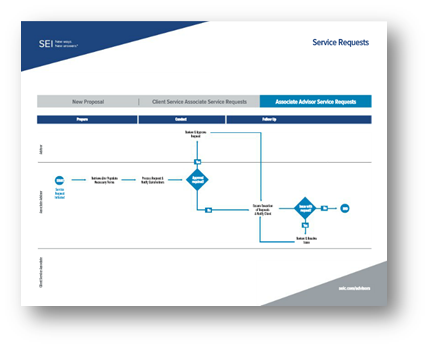
|
Tax Management
This workflow describes all the steps required for an Associate Advisor (AA) to initiate and manage a client service request. As opposed to the Client Service Associate (CSA), the AA typically manages the following Service Request processes: Strategy Management (Portfolio Level), Fee Management, Trade Requests, and Tax Management.
| Manual |
Diagram |
|

|
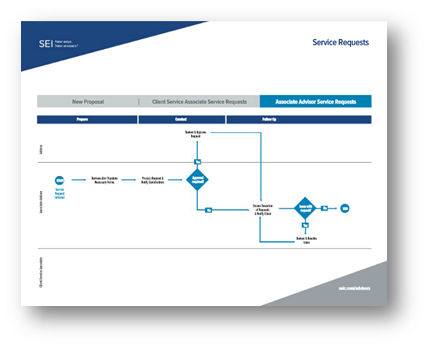
|
Trade Requests
This workflow describes all the steps required for an Associate Advisor (AA) to initiate and manage a client service request. As opposed to the Client Service Associate (CSA), the AA typically manages the following Service Request processes: Strategy Management (Portfolio Level), Fee Management, Trade Requests, and Tax Management.
| Manual |
Diagram |
|
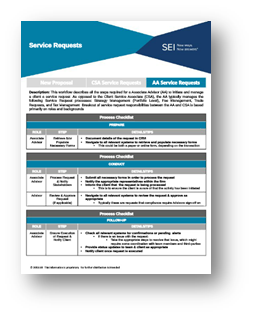
|
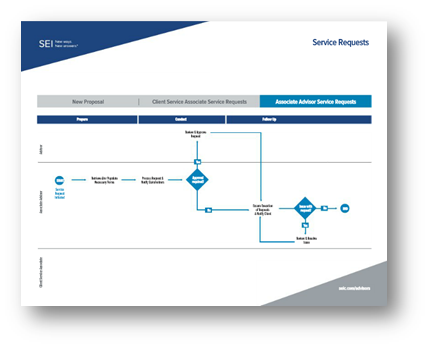
|